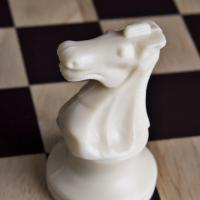
The First Scientific Theory of Chess
After receiving a request from a reader, I originally intended to write on the subject of chess strategy, but after some preparation and gathering of materials, I realized that a discussion of strategy alone would be akin to paddling a canoe in a turbulent ocean. It demands grounding on the safe beach of a theory of chess.
Almost all chess writers – titled chess masters included – use the term ‘theory’ as a layman understands the term. That is, by ‘theory’ they refer to the collective beliefs, maxims, and generalizations that exist among their peers at the present time. For example, one often reads that a particular move conforms to ‘opening theory’ as is periodically published in such daunting tomes as Modern Chess Openings or The Encyclopaedia of Chess Openings. In the middle game, ‘theory’ refers to general principles of play, such as that rooks belong on open files; and in the end game ‘theory’ is either similar advice, albeit informed by the experience of high-level play, or particular classes of positions with known outcomes if play continues with perfect and advance knowledge of the result.
However, I would like to employ the term ‘theory’ in its scientifically accepted sense. In that regard a theory of chess would take the form of an explanation of observed phenomena or data, the most important of which relate to how or whether games are won. That explanation may compete with other theories also set forth to explain the same data.
The history of science is replete with fascinating narratives of one theory supplanting another because it is discovered to more accurately or more succinctly account for the observations of interest. There are also other criteria that are important for a theory to be useful, such as that it have a predictive capability or that it be falsifiable.
To cite just one non-chess example, the germ theory of disease has, at least among educated people, replaced the alternative theory that disease is caused by evil spirits.
Behavior follows theory. Among a minority of the world’s inhabitants disease prevention and cure involves ritual incantations and other activities aimed at ridding the body of the spirits that do or threaten to inhabit it. For most of us, however, disease control involves behavior centered around environmental and personal sanitation, the handling of food, or the administration of medicines and vaccines. These radically different behaviors follow directly from the two incompatible theories of disease that one subscribes to.
What is the theory – or theories – of chess that compete for our belief systems? Until we answer this question we cannot intelligently discuss strategies, i.e. behaviors for playing the game.
I am certainly no expert on either the history of chess or its theoretical underpinnings, and I invite readers who disagree with what follows, or who have ‘pieces to fill the holes’, so to speak, to do so in the spirit of mutual teaching and learning. But I have only found one explanatory framework in my research that satisfies what I understand to be a scientific theory of chess, and that theory is more than a century old.

In 1886 at the age of 49, Wilhelm Steinitz defeated Johann Zukertort in a match of 20 games to become the world’s first official chess champion, a title which he held until 1894. In 1889, three years after claiming the championship and a hundred twenty years before the present time, Steinitz published a book called Modern Chess Instructor, Part I in which he brilliantly put forth the first scientific theory of chess.
In the sixth chapter that begins on page xxxi, Steinitz wrote his humble but profound theory: “…it is now conceded by all experts that by proper play on both sides the legitimate issue of a game ought to be a draw…” As if to underscore its importance by repetition, he wrote on the very next page that “The principal thesis of the modern school may be briefly summarized thus: … by best play on both sides a draw ought to be the legitimate result.”
Why is this claim to be properly understood as a scientific theory of chess rather than a personal prejudice? I will address this question when I post part 2 of this blog in a few days.

